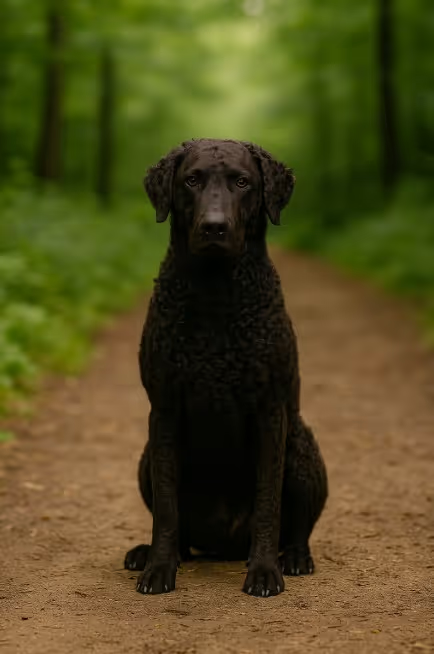The Curly-Coated Retriever is a bold, confident, and athletic gun dog known for its signature tight curls and spirited personality. As one of the oldest retriever breeds, it excels in water and field work while also being an affectionate family companion. Ideal for experienced and active owners, this breed balances independence with loyalty. Wondering “Are Curly-Coated Retrievers good apartment dogs?” They can adapt if their high exercise needs are met, but thrive in spacious environments.

Originating in England in the early 1800s, the Curly-Coated Retriever is one of the oldest retriever breeds. It was developed from crossbreeding Irish Water Spaniels, Poodles, and old English water dogs. Originally bred for retrieving game from land and water, its hallmark curly coat provided insulation and protection. The breed was highly favored by English gamekeepers and became one of the first retrievers shown in dog shows.
The Curly-Coated Retriever is distinguished by its tightly curled coat and elegant yet powerful build.
Despite its unique coat, the Curly-Coated Retriever is relatively low maintenance.
This is a high-energy breed bred for work, requiring consistent physical and mental stimulation.
Curly-Coated Retrievers are intelligent but can be independent and occasionally stubborn.
This active breed needs a balanced diet to support muscle tone and joint health.
Curly-Coated Retrievers are generally healthy but may face breed-specific issues.
Though rare, you can find responsible breeders and some rescue options in Canada.
Are Curly-Coated Retrievers good apartment dogs?
Only if exercised intensely; they do better with access to outdoor space.
Do Curly-Coated Retrievers shed?
Yes—but minimally. Their tight curls trap hair, which is released mostly during seasonal sheds.
Are Curly-Coated Retrievers hypoallergenic?
No. They are not hypoallergenic.
How much exercise do they need?
At least 60–90 minutes per day with access to mentally stimulating tasks.
Are they easy to train?
Yes—with consistent training, though they may be more independent than other retrievers.
Do they bark a lot?
They’re not excessive barkers but will alert when necessary.
Curly-Coated Retriever vs Labrador—what’s different?
Curly-Coats are leaner, more independent, and have a distinct curly coat; Labs are broader and more overtly social.
Is the coat hard to maintain?
No. A weekly brushing and occasional bath suffice; curls shouldn't be over-groomed.
Are they good with kids and other pets?
Yes—affectionate and playful, but early socialization is key due to their reserved nature.